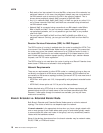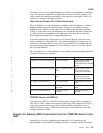v Both ends of an inter-network link must be BNs, unless one of the networks is a
peripheral network. In this case, the peripheral network may use a conventional
non-BN network node to connect to the BN in the adjoining network. This is
shown where peripheral network NetC connects to NetB with NNc.
v Any LU in networks NetA, NetB, NetC, NetD, or NetE can get to any other LU in
any of those networks. Both NetC and NetE are connected using conventional
non-BN network nodes.
v Network NetE is connected using conventional non-BN network node NNe to
BNs in NetA2 and NetF. You can not have a network node interconnecting
non-peripheral networks, so it is not possible to get from NetF to any network
other than NetE.
v You can get from NetA2 to NetE and from NetE to NetA2 since NNe is in a
peripheral network. Similarly, you can get from NetF to NetE and from NetE to
NetF.
Session Services Extensions (SSE) for NNS Support
The SSE function of a router is enabled when the router is enabled for APPN. This
is true even if the Extended Border Node function is not enabled. This means that
the router may act as the network node server for a VTAM end node. As such, it
can handle NNS functions for end nodes requesting SLU-initiated sessions, third
part initiated sessions, session request queuing, automatic login, session-release
requests, and EN TG vector registration.
The SSE function is not used when the router is acting as a Branch Extender since
down stream VTAMs are not allowed in that configuration.
Network Requirements
There are no requirements for other APPN nodes in a network as long as they are
not directly connected to a BN across a topology boundary. APPN nodes that are
connected to a BN across a topology boundary (across an ISTG) must meet one of
these requirements:
v APPN Ver1 with option set 1013, Interoperability with peripheral extended border
node
v APPN Ver2, where option set 1013 is part of the base software.
Nodes attached using ISTGs that do not meet either of these requirements will
generate alerts and do not handle some of the new flows associated with BNs.
However, if other paths through the network are available, you may still have
end-to-end connectivity.
Branch Extender vs. Extended Border Node
Both Branch Extender and Extended Border Nodes serve to minimize network
topology. The choice of which to use depends upon the network.
A branch extender is the appropriate choice when you have a single network with
one or more groups of end nodes where each group of end nodes typically needs
to communicate with other end nodes in that group, and only occasionally need to
interact with the backbone network.
None of the devices downstream from the branch extender may be network nodes,
DLUR, VTAM, or VTAM end nodes.
APPN
16
MRS V3.2 Protocol Config Ref Vol 2


















